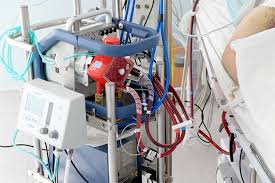Overview
In extracorporeal membrane oxygenation (ECMO), blood is pumped outside of your body to a heart-lung machine that removes carbon dioxide and sends oxygen-filled blood back to tissues in the body. Blood flows from the right side of the heart to the membrane oxygenator in the heart-lung machine, and then is rewarmed and sent back to the body.
Definition
Extracorporeal Membrane Oxygenation (ECMO) is an advanced technology that acts as a child’s heart and lungs to support a child who is recovering from surgery or disease, or during a surgical procedure.
ECMO is similar to heart-lung bypass machines used during open-heart surgery. While a child is on ECMO, blood gets oxygenated, by an artificial lung, and gets delivered to the whole body, using an external mechanical pump. The machine maintains the blood flow and oxygenation to the body’s vital organs while the child recovers, by allowing the heart and lungs to “rest” over several days to weeks.
This method allows the blood to “bypass” the heart and lungs, allowing these organs to rest and heal.
ECMO is used in critical care situations, when your heart and lungs need help so that you can heal. It may be used in care for COVID-19, ARDS and other infections.
Why it’s done
ECMO may be used to help people who are very ill with conditions of the heart and lungs, or who are waiting for or recovering from a heart transplant. It may be an option when other life support measures haven’t worked. ECMO does not treat or cure a disease, but can help you when your body temporarily can’t provide your tissues with enough oxygen.
Some heart conditions in which ECMO may be used include:
- Heart attack (acute myocardial infarction)
- Heart muscle disease (decompensated cardiomyopathy)
- Inflammation of the heart muscle (myocarditis)
- Life-threatening response to infection (sepsis)
- Low body temperature (severe hypothermia)
- Post-transplant complications
- Shock caused by the heart not pumping enough blood (cardiogenic shock)
Some lung (pulmonary) conditions in which ECMO may be used include:
- Acute respiratory distress syndrome (ARDS)
- Blockage in a pulmonary artery in the lungs (pulmonary embolism)
- Coronavirus disease 2019 (COVID-19)
- Defect in the diaphragm (congenital diaphragmatic hernia)
- Fetus inhales waste products in the womb (meconium aspiration)
- Flu (influenza)
- Hantavirus pulmonary syndrome
- High blood pressure in the lungs (pulmonary hypertension)
- Pneumonia
- Respiratory failure
- Trauma
Risks
The most common risks that may occur with ECMO include:
- Bleeding
- Blood clot (thromboembolism)
- Blood clotting disorder (coagulopathy)
- Infection
- Loss of blood in hands, feet or legs (limb ischemia)
- Seizures
- Stroke (part of the brain is damaged by loss of blood or by a blood vessel that bursts)
How you prepare
ECMO is used when life support is needed after surgery, or when you are very ill and your heart or lungs need help so that you can heal. Your doctor will decide when it may be helpful. If you need ECMO, your doctor and trained respiratory therapists will prepare you.
What you can expect
Your doctor will insert a thin, flexible tube (cannula) into a vein to draw out blood and a second tube into a vein or artery to return warmed blood with oxygen to your body. You will receive other medications, including sedation, to make you comfortable while receiving ECMO, and may not be able to talk during this time.
Depending on your condition, ECMO can be used for a few days to a few weeks. The amount of time you receive ECMO depends on your condition. Your doctor will talk with you or your family about what to expect.
ECMO Resources American Thoracic Society Download Here
Results
The outcomes associated with ECMO depend upon the severity of the health condition that led to use of ECMO. Your doctor can explain how helpful ECMO may be in your situation.

